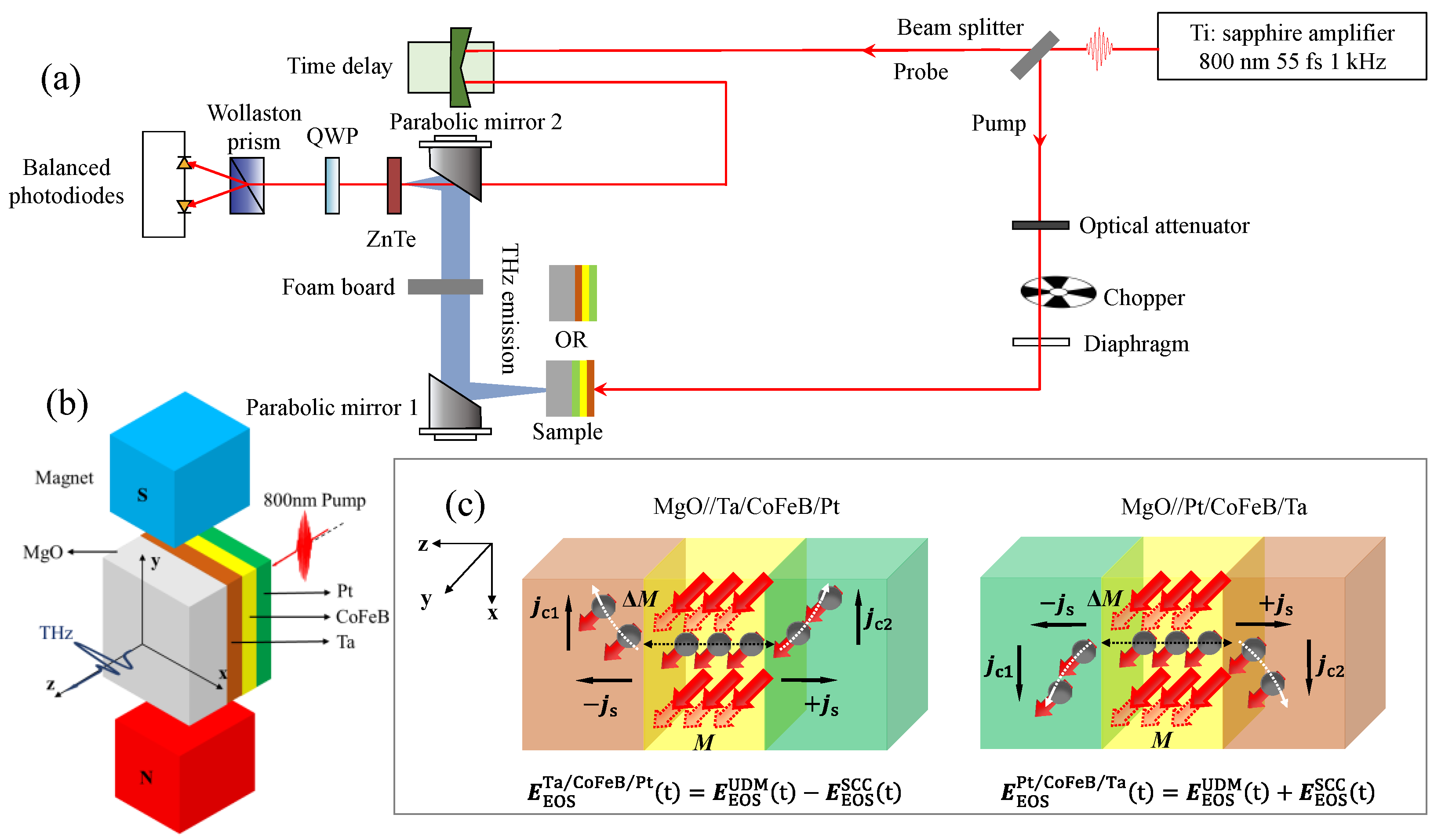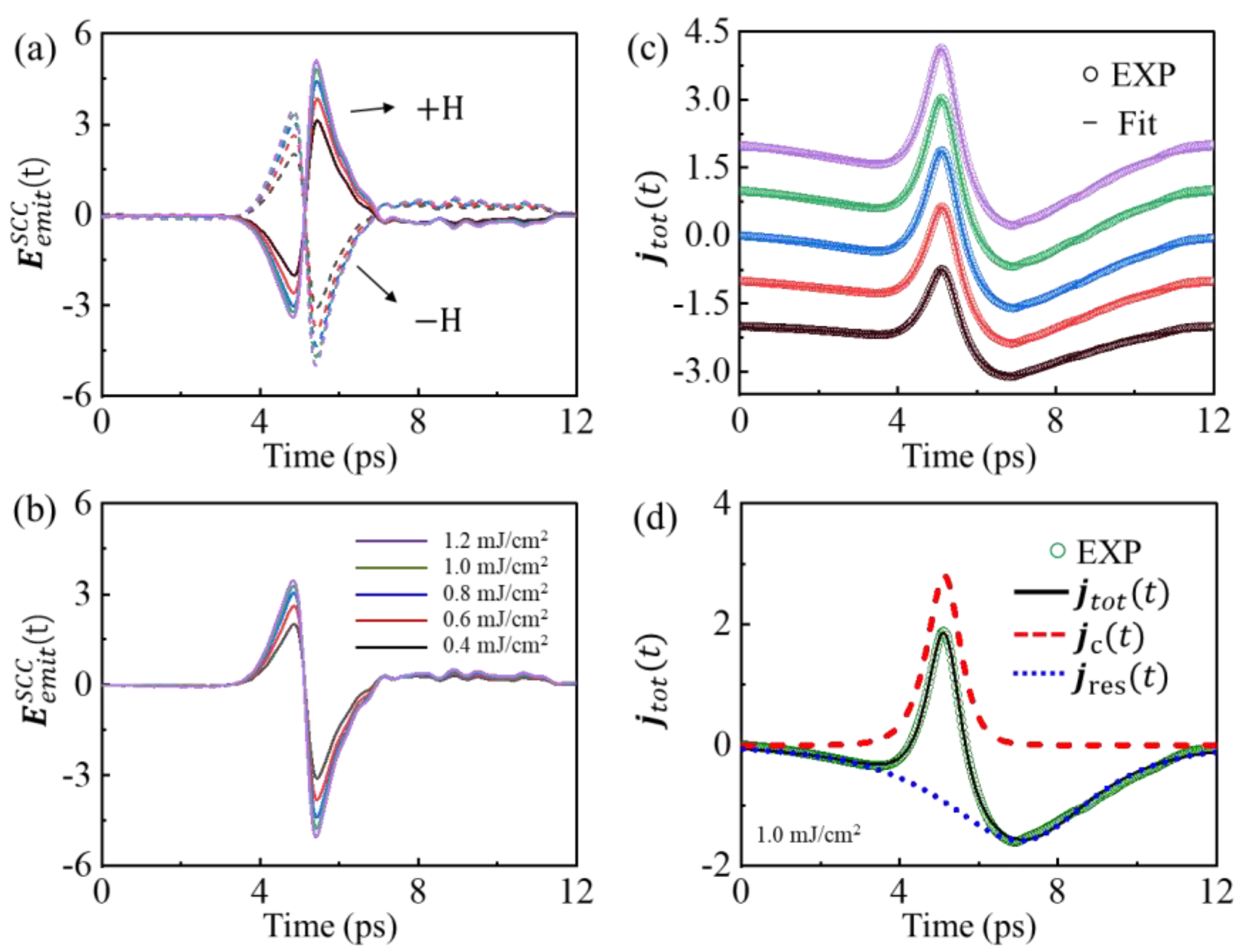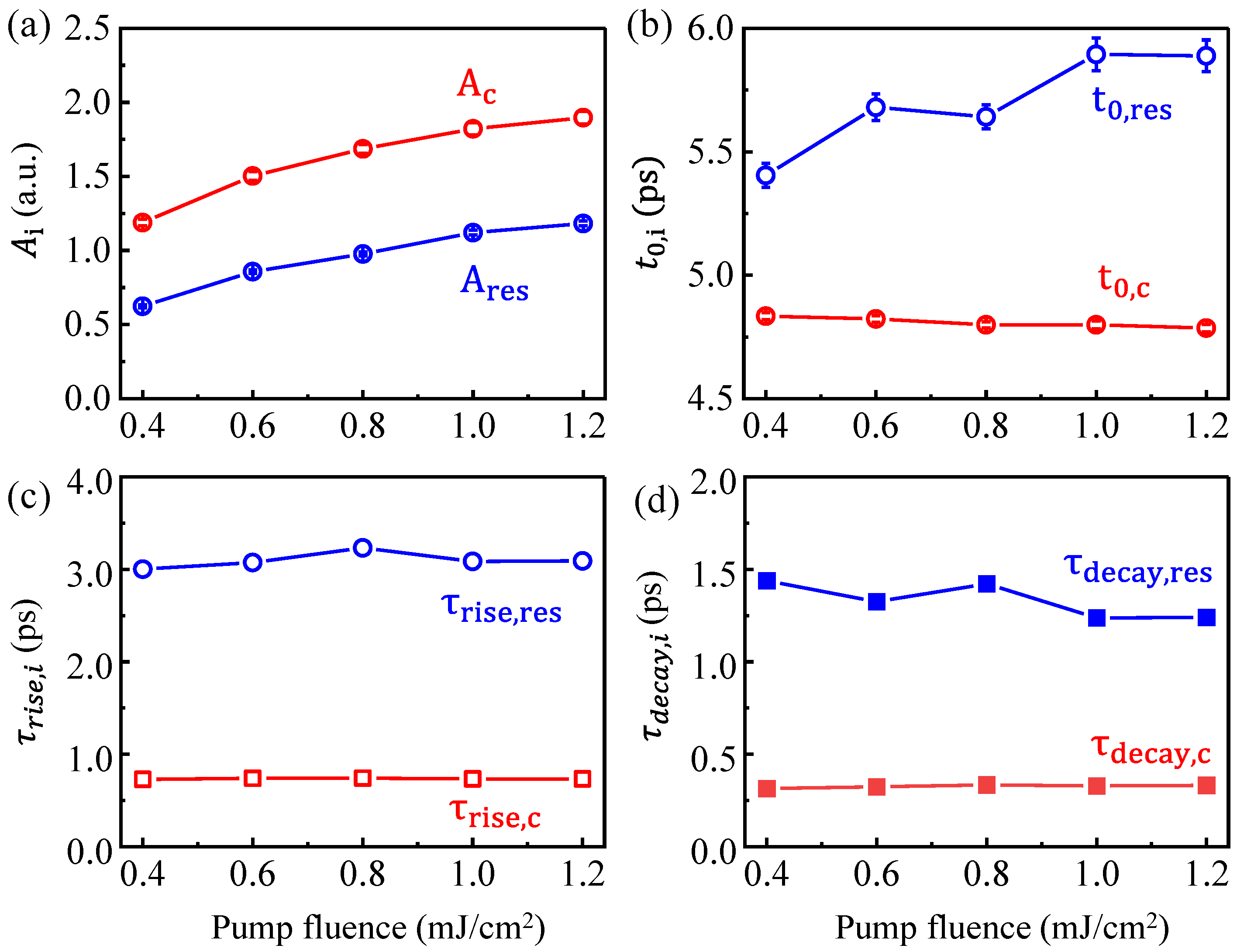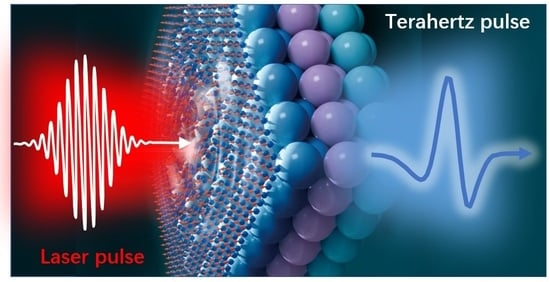Terahertz Emission Spectroscopy of Ultrafast Coupled Spin and Charge Dynamics in Nanometer Ferromagnetic Heterostructures
Abstract
1. Introduction
2. Materials and Methods
2.1. Thin Films Preparation
2.2. Terahertz Emission Spectroscopy
3. Results and Discussion
4. Conclusions
Supplementary Materials
Author Contributions
Funding
Institutional Review Board Statement
Informed Consent Statement
Data Availability Statement
Conflicts of Interest
References
- Beaurepaire, E.; Merle, J.C.; Daunois, A.; Bigot, J.Y. Ultrafast spin dynamics in ferromagnetic nickel. Phys. Rev. Lett. 1996, 76, 4250–4253. [Google Scholar] [CrossRef]
- Kirilyuk, A.; Kimel, A.V.; Rasing, T. Ultrafast optical manipulation of magnetic order. Rev. Mod. Phys. 2010, 82, 2731–2784. [Google Scholar] [CrossRef]
- Kimel, A.V.; Kirilyuk, A.; Usachev, P.A.; Pisarev, R.V.; Balbashov, A.M.; Rasing, T. Ultrafast non-thermal control of magnetization by instantaneous photomagnetic pulses. Nature 2005, 435, 655–657. [Google Scholar] [CrossRef] [PubMed]
- Zhang, G.P.; Hübner, W.; Lefkidis, G.; Bai, Y.H.; George, T.F. Paradigm of the time-resolved magneto-optical Kerr effect for femtosecond magnetism. Nat. Phys. 2009, 5, 499–502. [Google Scholar] [CrossRef]
- Bigot, J.Y.; Vomir, M.; Beaurepaire, E. Coherent ultrafast magnetism induced by femtosecond laser pulses. Nat. Phys. 2009, 5, 515–520. [Google Scholar] [CrossRef]
- Vahaplar, K.; Kalashnikova, A.M.; Kimel, A.V.; Hinzke, D.; Nowak, U.; Chantrell, R.; Tsukamoto, A.; Itoh, A.; Kirilyuk, A.; Rasinget, T. Ultrafast path for optical magnetization reversal via a strongly nonequilibrium state. Phys. Rev. Lett. 2009, 103, 117201. [Google Scholar] [CrossRef]
- Lambert, C.H.; Mangin, S.; Varaprasad, B.S.D.C.S.; Takahashi, Y.K.; Hehn, M.; Cinchetti, M.; Malinowski, G.; Hono, K.; Fainman, Y.; Aeschlimann, M.; et al. All-optical control of ferromagnetic thin films and nanostructures. Science 2014, 345, 1337–1340. [Google Scholar] [CrossRef] [PubMed]
- Tauchert, S.R.; Volkov, M.; Ehberger, D.; Kazenwadel, D.; Evers, M.; Lange, H.; Donges, A.; Book, A.; Kreuzpaintner, W.; Nowak, U.; et al. Polarized phonons carry angular momentum in ultrafast demagnetization. Nature 2022, 602, 73–77. [Google Scholar] [CrossRef]
- Philippe, S.; Quentin, R.; Sébastien, L.; Gregory, M.; Stéphane, M. Light induced ultrafast magnetization dynamics in metallic compounds. J. Magn. Magn. Mater. 2022, 560, 169596. [Google Scholar] [CrossRef]
- Wang, S.C.; Wei, C.; Feng, Y.H.; Cao, H.K.; Li, W.Z.; Cao, Y.Y.; Guan, B.O.; Tsukamoto, A.; Kirilyuk, A.; Kimel, A.V.; et al. Dual-shot dynamics and ultimate frequency of all-optical magnetic recording on GdFeCo. Light Sci. Appl. 2021, 10, 8. [Google Scholar] [CrossRef] [PubMed]
- Malinowski, G.; Longa, F.D.; Rietjens, J.H.H.; Paluskar, P.V.; Huijink, R.; Swagten, H.J.M.; Koopmans, B. Control of speed and efficiency of ultrafast demagnetization by direct transfer of spin angular momentum. Nat. Phys. 2008, 4, 855–858. [Google Scholar] [CrossRef]
- Rudolf, D.; La-O-Vorakiat, C.; Battiato, M.; Adam, R.; Shaw, J.M.; Turgut, E.; Maldonado, P.; Mathias, S.; Grychtol, P.; Nembach, H.T.; et al. Ultrafast magnetization enhancement in metallic multilayers driven by superdiffusive spin current. Nat. Commun. 2012, 3, 1037. [Google Scholar] [CrossRef] [PubMed]
- Choi, G.M.; Moon, C.H.; Min, B.C.; Lee, K.J.; Cahill, D.G. Thermal spin-transfer torque driven by the spin-dependent Seebeck effect in metallic spin-valves. Nat. Phys. 2015, 11, 576–581. [Google Scholar] [CrossRef]
- Melnikov, A.; Razdolski, I.; Wehling, T.O.; Papaioannou, E.T.; Roddatis, V.; Fumagalli, P.; Aktsipetrov, O.; Lichtenstein, A.I.; Bovensiepen, U. Ultrafast transport of laser-excited spin-polarized carriers in Au/Fe/MgO(001). Phys. Rev. Lett. 2011, 107, 076601. [Google Scholar] [CrossRef] [PubMed]
- Battiato, M.; Carva, K.; Oppeneer, P.M. Superdiffusive spin transport as a mechanism of ultrafast demagnetization. Phys. Rev. Lett. 2010, 105, 027203. [Google Scholar] [CrossRef]
- Carpene, E.; Mancini, E.; Dallera, C.; Brenna, M.; Puppin, E.; De Silvestri, S. Dynamics of electron-magnon interaction and ultrafast demagnetization in thin iron films. Phys. Rev. B 2008, 78, 174422. [Google Scholar] [CrossRef]
- Koopmans, B.; Malinowski, G.; Longa, F.D.; Steiauf, D.; Fähnle, M.; Roth, T.; Cinchetti, M.; Aeschlimann, M. Explaining the paradoxical diversity of ultrafast laser-induced demagnetization. Nat. Mater. 2010, 9, 259–265. [Google Scholar] [CrossRef]
- Turgut, E.; Grychtol, P.; La-O-Vorakiat, C.; Adams, D.E.; Kapteyn, H.C.; Murnane, M.M.; Mathias, S.; Aeschlimann, M.; Schneider, C.M.; Shaw, J.M.; et al. Publisher’s Note: Reply to “Comment on ‘Ultrafast Demagnetization Measurements Using Extreme Ultraviolet Light: Comparison of Electronic and Magnetic Contributions’” [Phys. Rev. X3, 038002 (2013)PRXHAE2160-3308]. Phys. Rev. X 2013, 3, 039901. [Google Scholar] [CrossRef]
- Peng, Y.; Shi, C.J.; Zhu, Y.M.; Gu, M.; Zhuang, S.L. Terahertz spectroscopy in biomedical field: A review on signal-to-noise ratio improvement. Phys. Rev. Lett. 2020, 1, 12. [Google Scholar] [CrossRef]
- Peng, Y.; Huang, J.L.; Luo, J.; Yang, Z.F.; Wang, L.P.; Wu, X.; Zang, X.F.; Yu, C.; Gu, M.; Hu, Q.; et al. Three-step one-way model in terahertz biomedical detection. PhotoniX 2022, 2, 12. [Google Scholar] [CrossRef]
- Kampfrath, T.; Sell, A.; Klatt, G.; Pashkin, A.; Mährlein, S.; Dekorsy, T.; Wolf, M.; Fiebig, M.; Leitenstorfer, A.; Huber, R. Coherent terahertz control of antiferromagnetic spin waves. Nat. Photonics 2011, 5, 31–34. [Google Scholar] [CrossRef]
- Jin, Z.M.; Mics, Z.; Ma, G.H.; Cheng, Z.; Bonn, M.; Turchinovich, D. Single-pulse terahertz coherent control of spin resonance in the canted antiferromagnet YFeO3, mediated by dielectric anisotropy. Phys. Rev. B 2013, 87, 094422. [Google Scholar] [CrossRef]
- Nova, T.F.; Cartella, A.; Cantaluppi, A.; Forst, M.; Bossini, D.; Mikhaylovskiy, R.V.; Kimel, A.V.; Merlin, R.; Cavalleri, A. An effective magnetic field from optically driven phonons. Nat. Phys. 2017, 13, 132–136. [Google Scholar] [CrossRef]
- Baierl, S.; Hohenleutner, M.; Kampfrath, T.; Zvezdin, A.; Kimel, A.; Huber, R.; Mikhaylovskiy, R. Nonlinear spin control by terahertz-driven anisotropy fields. Nat. Photonics 2016, 10, 715–721. [Google Scholar] [CrossRef]
- Kampfrath, T.; Tanaka, K.; Nelson, K. Resonant and nonresonant control over matter and light by intense terahertz transients. Nat. Photonics 2013, 7, 680–690. [Google Scholar] [CrossRef]
- Jin, Z.M.; Tkach, A.; Casper, F.; Spetter, V.; Grimm, H.; Thomas, A.; Kampfrath, T.; Bonn, M.; Kläui, M.; Turchinovich, D. Accessing the fundamentals of magnetotransport in metals with terahertz probes. Nat. Phys. 2015, 11, 761–766. [Google Scholar] [CrossRef]
- Jin, Z.M.; Li, J.G.; Zhang, W.J.; Guo, C.Y.; Wan, C.H.; Han, X.F.; Cheng, Z.X.; Zhang, C.; Balakin, A.V.; Shkurinov, A.P.; et al. Magnetic modulation of terahertz waves via spin-polarized electron tunneling based on magnetic tunnel junctions. Phys. Rev. Appl. 2020, 14, 014032. [Google Scholar] [CrossRef]
- Neeraj, K.; Awari, N.; Kovalev, S.; Polley, D.; Hagström, N.Z.; Arekapudi, S.S.P.K.; Semisalova, A.; Lenz, K.; Green, B.; Deinert, J.C.; et al. Inertial spin dynamics in ferromagnets. Nat. Phys. 2021, 17, 245–250. [Google Scholar] [CrossRef]
- Vicario, C.; Ruchert, C.; Ardana-Lamas, F.; Derlet, P.M.; Tudu, B.; Luning, J.; Hauri, C.P. Off-resonant magnetization dynamics phase-locked to an intense phase-stable terahertz transient. Nat. Photonics 2013, 7, 720–723. [Google Scholar] [CrossRef]
- Walowski, J.; Münzenberg, M. Perspective: Ultrafast magnetism and THz spintronics. J. Appl. Phys. 2016, 120, 140901. [Google Scholar] [CrossRef]
- Beaurepaire, E.; Turner, G.M.; Harrel, S.M.; Beard, M.C.; Bigot, J.Y.; Schmuttenmaer, C.A. Coherent terahertz emission from ferromagnetic films excited by femtosecond laser pulses. Appl. Phys. Lett. 2004, 84, 3465–3467. [Google Scholar] [CrossRef]
- Zhang, W.T.; Maldonado, P.; Jin, Z.M.; Seifert, T.S.; Arabski, J.; Schmerber, G.; Beaurepaire, E.; Bonn, M.; Kampfrath, T.; Oppeneer, P.M.; et al. Ultrafast terahertz magnetometry. Nat. Commun. 2020, 11, 4247. [Google Scholar] [CrossRef] [PubMed]
- Kampfrath, T.; Battiato, M.; Maldonado, P.; Eilers, G.; Nötzold, J.; Mährlein, S.; Zbarsky, V.; Freimuth, F.; Mokrousov, Y.; Blügel, S.; et al. Terahertz spin current pulses controlled by magnetic heterostructures. Nat. Nanotechnol. 2013, 8, 256–260. [Google Scholar] [CrossRef]
- Seifert, T.; Jaiswal, S.; Martens, U.; Hannegan, J.; Braun, L.; Maldonado, P.; Freimuth, F.; Kronenberg, A.; Henrizi, J.; Radu, I.; et al. Efficient metallic spintronic emitters of ultrabroadband terahertz radiation. Nat. Photonics 2016, 10, 483–488. [Google Scholar] [CrossRef]
- Cheng, L.; Wang, X.B.; Yang, W.F.; Chai, J.W.; Yang, M.; Chen, M.J.; Wu, Y.; Chen, X.X.; Chi, D.Z.; Goh, K.E.J.; et al. Far out-of-equilibrium spin populations trigger giant spin injection into atomically thin MoS2. Nat. Phys. 2019, 15, 347. [Google Scholar] [CrossRef]
- Huisman, T.J.; Mikhaylovskiy, R.V.; Costa, J.D.; Freimuth, F.; Paz, E.; Ventura, J.; Freitas, P.P.; Blügel, S.; Mokrousov, Y.; Rasing, T.; et al. Femtosecond control of electric currents in metallic ferromagnetic heterostructures. Nat. Nanotechnol. 2016, 11, 455. [Google Scholar] [CrossRef]
- Zhou, C.; Liu, Y.P.; Wang, Z.; Ma, S.J.; Jia, M.W.; Wu, R.Q.; Zhou, L.; Zhang, W.; Liu, M.K.; Wu, Y.Z.; et al. Broadband terahertz generation via the interface inverse Rashba-Edelstein effect. Phys. Rev. Lett. 2018, 121, 086801. [Google Scholar] [CrossRef]
- Jungfleisch, M.B.; Zhang, Q.; Zhang, W.; Pearson, J.E.; Schaller, R.D.; Wen, H.D.; Hoffmann, A. Control of terahertz emission by ultrafast spin-charge current conversion at Rashba interfaces. Phys. Rev. Lett. 2018, 120, 207207. [Google Scholar] [CrossRef]
- Shen, J.H.; Feng, Z.; Xu, P.C.; Hou, D.Z.; Gao, Y.; Jin, X.F. Spin-to-charge conversion in Ag/Bi bilayer revisited. Phys. Rev. Lett. 2021, 126, 197201. [Google Scholar] [CrossRef]
- Zhang, Q.; Luo, Z.Y.; Li, H.; Yang, Y.M.; Zhang, X.H.; Wu, Y.H. Terahertz emission from anomalous Hall effect in a single-layer ferromagnet. Phys. Rev. Appl. 2019, 12, 054027. [Google Scholar] [CrossRef]
- Bulgarevich, D.S.; Akamine, Y.; Talara, M.; Mag-usara, V.; Kitahara, H.; Kato, H.; Shiihara, M.; Tani, M.; Watanabe, M. Terahertz magneto-optic sensor/imager. Sci. Rep. 2020, 10, 1158. [Google Scholar] [CrossRef]
- Chen, S.C.; Feng, Z.; Li, J.; Tan, W.; Du, L.H.; Cai, J.W.; Ma, Y.C.; He, K.; Ding, H.F.; Zhai, Z.H.; et al. Ghost spintronic THz-emitter-array microscope. Light Sci. Appl. 2020, 9, 99. [Google Scholar] [CrossRef]
- Turgut, E.; La-o-vorakiat, C.; Shaw, J.M.; Grychtol, P.; Nembach, H.T.; Rudolf, D.; Adam, R.; Aeschlimann, M.; Schneider, C.M.; Silva, T.J.; et al. Controlling the competition between optically induced ultrafast spin-flip scattering and spin transport in magnetic multilayers. Phys. Rev. Lett. 2013, 110, 197201. [Google Scholar] [CrossRef]
- Huisman, T.J.; Mikhaylovskiy, R.V.; Tsukamoto, A.; Rasing, T.; Kimel, A.V. Simultaneous measurements of terahertz emission and magneto-optical Kerr effect for resolving ultrafast laser-induced demagnetization dynamics. Phys. Rev. B 2015, 92, 104419. [Google Scholar] [CrossRef]
- Wu, Y.; Elyasi, M.; Qiu, X.P.; Chen, M.J.; Liu, Y.; Ke, L.; Yang, H. High-performance THz emitters based on ferromagnetic/nonmagnetic heterostructures. Adv. Mater. 2017, 29, 1603031. [Google Scholar] [CrossRef]
- Schneider, R.; Fix, M.; Bensmann, J.; de Vasconcellos, S.M.; Albrecht, M.; Bratschitsch, R. Spintronic GdFe/Pt THz emitters. Appl. Phys. Lett. 2019, 115, 152401. [Google Scholar] [CrossRef]
- Cramer, J.; Seifert, T.; Kronenberg, A.; Fuhrmann, F.; Jakob, G.; Jourdan, M.; Kampfrath, T.; Klaeui, M. Complex terahertz and direct current inverse spin hall effect in YIG/Cu1−xIrx bilayers across a wide concentration range. Nano Lett. 2018, 18, 1064–1069. [Google Scholar] [CrossRef]
- Johnson, P.B.; Christy, R.W. Optical constants of transition metals: Ti, V, Cr, Mn, Fe, Co, Ni, and Pd. Phys. Rev. B 1974, 9, 5056–5070. [Google Scholar] [CrossRef]
- Zhang, S.N.; Zhu, W.H.; Li, J.G.; Jin, Z.M.; Dai, Y.; Zhang, Z.Z.; Ma, G.H.; Yao, J.Q. Coherent terahertz radiation via ultrafast manipulation of spin currents in ferromagnetic heterostructures. Acta Phys. Sin. 2018, 67, 197202. [Google Scholar] [CrossRef]
- Zhang, S.N.; Jin, Z.M.; Liu, X.M.; Zhao, W.Y.; Lin, X.; Jing, C.; Ma, G.H. Photoinduced terahertz radiation and negative conductivity dynamics in Heusler alloy Co2MnSn film. Opt. Lett. 2017, 42, 3080. [Google Scholar] [CrossRef]
- Liu, Y.S.; Cheng, H.Y.; Xu, Y.; Vallobra, P.; Eimer, S.; Zhang, X.Q.; Wu, X.J.; Nie, T.X.; Zhao, W.S. Separation of emission mechanisms in spintronic terahertz emitters. Phys. Rev. B 2021, 104, 064419. [Google Scholar] [CrossRef]
- Mueller, B.Y.; Roth, T.; Cinchetti, M.; Aeschlimann, M.; Rethfeld, B. Driving force of ultrafast magnetization dynamics. New J. Phys. 2021, 13, 123010. [Google Scholar] [CrossRef]
- Rouzegar, R.; Brandt, L.; Nadvornik, L.; Reiss, D.A.; Chekhov, A.L.; Gueckstock, O.; In, C.; Wolf, M.; Seifert, T.S.; Brouwer, P.W.; et al. Laser-induced terahertz spin transport in magnetic nanostructures arises from the same force as ultrafast demagnetization. Phys. Rev. B 2022, 106, 144427. [Google Scholar] [CrossRef]
- Jiménez-Cavero, P.; Gueckstock, O.; Nádvorník, L.; Lucas, I.; Seifert, T.S.; Wolf, M.; Rouzegar, R.; Brouwer, P.W.; Becker, S.; Jakob, G.; et al. Transition of laser-induced terahertz spin currents from torque- to conduction-electron-mediated transport. Phys. Rev. B 2022, 105, 184408. [Google Scholar] [CrossRef]
- Zhang, W.T.; Turchinovich, D. Rigorous signal reconstruction in terahertz emission spectroscopy. Opt. Express 2021, 29, 24411–24421. [Google Scholar] [CrossRef] [PubMed]
- Faure, J.; Van Tilborg, J.; Kaindl, R.A.; Leemans, W.P. Modelling laser-based table-top THz sources: Optical rectification, propagation and electro-optic sampling. Opt. Quantum Electron. 2004, 36, 681–697. [Google Scholar] [CrossRef]
- Georg, S.; Bikash, D.M.; Evangelos, T.P. Charge dynamics in spintronic THz emitters. arXiv 2021, arXiv:2208.07616. [Google Scholar] [CrossRef]
- Yang, Y.S.; Dal Forno, S.; Battiato, M. Transfer-matrix description of heterostructured spintronics terahertz emitters. Phys. Rev. B 2022, 104, 155437. [Google Scholar] [CrossRef]
- Agarwal, P.; Yang, Y.S.; Lourembam, J.; Medwal, R.; Battiato, M.; Singh, R. Terahertz spintronic magnetometer (TSM). Appl. Phys. Lett. 2022, 120, 161104. [Google Scholar] [CrossRef]
- Jin, Z.M.; Peng, Y.; Ni, Y.Y.; Wu, G.J.; Ji, B.Y.; Wu, X.; Zhang, Z.Z.; Ma, G.H.; Zhang, C.; Chen, L.; et al. Cascaded amplification and manipulation of terahertz emission by flexible spintronic heterostructures. Laser Photonics Rev. 2022, 16, 2100688. [Google Scholar] [CrossRef]





Publisher’s Note: MDPI stays neutral with regard to jurisdictional claims in published maps and institutional affiliations. |
© 2022 by the authors. Licensee MDPI, Basel, Switzerland. This article is an open access article distributed under the terms and conditions of the Creative Commons Attribution (CC BY) license (https://creativecommons.org/licenses/by/4.0/).
Share and Cite
Li, Z.; Jiang, Y.; Jin, Z.; Li, Z.; Lu, X.; Ye, Z.; Pang, J.-Y.; Xu, Y.; Peng, Y. Terahertz Emission Spectroscopy of Ultrafast Coupled Spin and Charge Dynamics in Nanometer Ferromagnetic Heterostructures. Nanomaterials 2022, 12, 4267. https://doi.org/10.3390/nano12234267
Li Z, Jiang Y, Jin Z, Li Z, Lu X, Ye Z, Pang J-Y, Xu Y, Peng Y. Terahertz Emission Spectroscopy of Ultrafast Coupled Spin and Charge Dynamics in Nanometer Ferromagnetic Heterostructures. Nanomaterials. 2022; 12(23):4267. https://doi.org/10.3390/nano12234267
Chicago/Turabian StyleLi, Zhangshun, Yexin Jiang, Zuanming Jin, Zhuoyi Li, Xianyang Lu, Zhijiang Ye, Jin-Yi Pang, Yongbing Xu, and Yan Peng. 2022. "Terahertz Emission Spectroscopy of Ultrafast Coupled Spin and Charge Dynamics in Nanometer Ferromagnetic Heterostructures" Nanomaterials 12, no. 23: 4267. https://doi.org/10.3390/nano12234267
APA StyleLi, Z., Jiang, Y., Jin, Z., Li, Z., Lu, X., Ye, Z., Pang, J.-Y., Xu, Y., & Peng, Y. (2022). Terahertz Emission Spectroscopy of Ultrafast Coupled Spin and Charge Dynamics in Nanometer Ferromagnetic Heterostructures. Nanomaterials, 12(23), 4267. https://doi.org/10.3390/nano12234267








